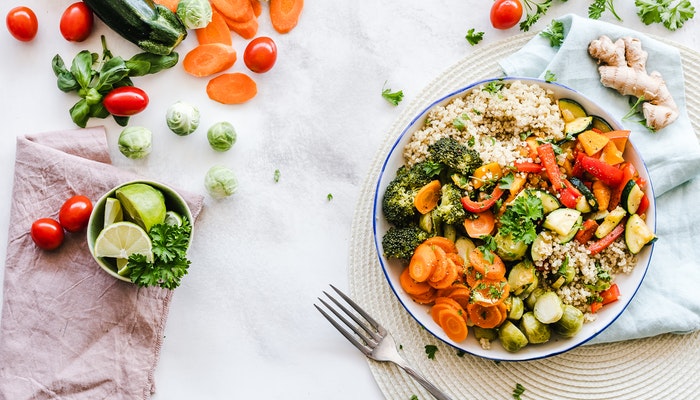
Give Yourself a low-FODMAP Gut Check with Weekly Meal Planning
If you’re someone who’s struggling with food sensitivities or gastrointestinal diseases that make you adopt dietary restrictions like a low-FODMAP diet, then you may find yourself searching for answers. A weekly meal plan may be just the ticket to recenter yourself both physically and emotionally.
But let’s face it — meal planning is easier said than done. Between the mental gymnastics of figuring out a menu, portions, and food diversity, it’s hard to even know where to begin.
That’s where we come in. In this post, we’ll help you get started on a meal planning journey for people with sensitive stomachs, and show you that meal prepping isn’t only for fitness lifestyle influencers. In fact, eating healthier is a practical decision to make for a more fulfilling life.
The Benefits of Weekly Meal Planning
Before we jump into how to get started on your weekly meal plan, it’s important to understand how meal prepping can improve both your physical and mental wellbeing.
Meal Planning for Physical Health
If you suffer from gastrointestinal distress, then low-FODMAP meal planning could be the solution you are looking for. FODMAPs are foods that commonly cause symptoms of IBS and consist of short-chain carbohydrates (or sugars) that aren’t properly absorbed in the digestive tract.
By systematically reducing your intake of FODMAPs (or removing them entirely), you can save yourself from pain.
FODMAPs include:
- Fructans: Found in many grains such as barley, wheat, and rye.
- Fructose: A simple sugar present in fruits and vegetables. They also make up the base for several added sugars.
- Galactans: Contain chains of galactose, which is present in legumes.
- Lactose: Sugar that’s found in cow’s milk and many dairy products.
- Polyols: A sugar alcohol found in fruits, vegetables, and sweeteners.
Meal Planning for Your Mental Health
Although suffering with gastrointestinal issues may be embarrassing and awkward, it can also severely impact your mental health. Those who suffer with IBS are found to be associated with higher levels of anxiety, depression, and a poor quality of life.
Through meal planning, you can find happiness in work and other social experiences again. Saving yourself from foods that physically pain you will ultimately free you from mental anguish.
How To Start Your Weekly Meal Plan
Getting started on a weekly meal plan for people with food sensitivities is the first step when taking your life back into your own hands.
- Stick to 3 Meals and 3 Snacks Every Day
It goes without saying that you should consistently be having breakfast, lunch, and dinner every single day of the week. But by balancing your meals with intermittent snacks in the morning and evening (before lunch and dinner, respectively), you can keep your cravings at bay while promoting a healthy lifestyle.
Don’t worry — we didn’t forget about dessert! Plan a small, sweet treat for yourself after dinner. If your stomach is cramping just reading the word “desert,” don’t fret, there are plenty of replacement, low-FODMAP options for you.
- Plan It Out
Before heading to the grocery store, use this detailed meal planning template to write down your meals for the week. By following the rules of your low-FODMAP diet and the food replacement guide, you can still find joy in food while following your dietary restrictions.
If you’re somebody with a sweet tooth that craves ice cream before bed, replace it with a scoop of coconut yogurt or sorbet!
A Low-FODMAP Diet Food Replacement Guide
If you’re still scratching your head trying to figure out what kind of food is right for you while you’re on a low-FODMAP diet, keep reading to see a detailed guide for every meal. These low-FODMAP meals can even include gluten-free dishes.
A Low-FODMAP Breakfast
High-FODMAP foods are common in the average breakfast. A bowl of cereal with cow’s milk should be avoided, but can be replaced with almond milk, or enjoy a coconut yogurt parfait with blueberries (not blackberries, though). Avoid toast, but embrace oatmeal and grits.
A Guide to a Low-FODMAP Lunch
Sandwiches on traditional bread are a no-go for low-FODMAP diets. However, you can easily replace the bread with a low-carb tortilla or corn tortilla and turn it into a wrap. Or, if you’re feeling fancy, sourdough bread is a great alternative to white or wheat bread. When making your daily salad, stick to lettuce and spinach while staying away from cabbage.
Low-FODMAP Dinner Guide
Unfortunately, a lot of vegetables and grains that make up a hearty dinner should be out of the question for your low-FODMAP diet. Stay away from pastas unless they are gluten-free. Most healthy meats like beef, chicken, fish, and pork are a great addition to your diet and can be utilized throughout the week with a side of mashed potatoes and green beans (but say no to asparagus).
Embrace Some Low-FODMAP Snacks
Although you can’t snack on a bowl of cherries or watermelon while on a low-FODMAP diet, you can find great replacements for them with bananas, grapes, and kiwis. A side of rice is a nice and simple way to fill up between meals, as well as a serving of corn chips. Want to skip the after-dinner dessert? Wind down with some popcorn to fill you up before going to bed.
Check out this printable low-FODMAP “eat this, not that” guide to find other great swaps.
Source: Everlywell
Now that you have a comprehensive list of low-FODMAP foods and a guide to get you started on a weekly meal plan, it’s time to put the ideas into action. Create a healthier tomorrow by creating good habits today.



